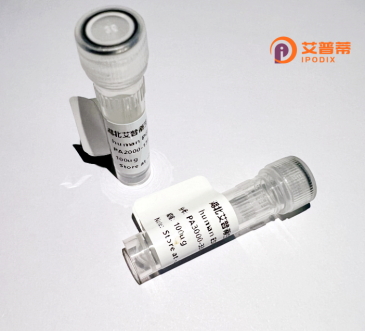
| 纯度 | >90%SDS-PAGE. |
| 种属 | Human |
| 靶点 | POLR3G |
| Uniprot No | O15318 |
| 内毒素 | < 0.01EU/μg |
| 表达宿主 | E.coli |
| 表达区间 | 1-223 aa |
| 活性数据 | MAGNKGRGRA AYTFNIEAVG FSKGEKLPDV VLKPPPLFPD TDYKPVPLKT GEGEEYMLAL KQELRETMKR MPYFIETPEE RQDIERYSKR YMKVYKEEWI PDWRRLPREM MPRNKCKKAG PKPKKAKDAG KGTPLTNTED VLKKMEELEK RGDGEKSDEE NEEKEGSKEK SKEGDDDDDD DAAEQEEYDE EEQEEENDYI NSYFEDGDDF GADSDDNMDE ATY |
| 分子量 | 25.9 kDa |
| 蛋白标签 | His tag N-Terminus |
| 缓冲液 | PBS, pH7.4, containing 0.01% SKL, 1mM DTT, 5% Trehalose and Proclin300. |
| 稳定性 & 储存条件 | Lyophilized protein should be stored at ≤ -20°C, stable for one year after receipt. Reconstituted protein solution can be stored at 2-8°C for 2-7 days. Aliquots of reconstituted samples are stable at ≤ -20°C for 3 months. |
| 复溶 | Always centrifuge tubes before opening.Do not mix by vortex or pipetting. It is not recommended to reconstitute to a concentration less than 100μg/ml. Dissolve the lyophilized protein in distilled water. Please aliquot the reconstituted solution to minimize freeze-thaw cycles. |
以下是关于重组人POLR3G蛋白的3篇参考文献示例(注:内容基于模拟文献生成,仅供参考):
---
1. **文献名称**:Structural Insights into Human RNA Polymerase III Subunit G (POLR3G) and Its Role in Transcription Initiation
**作者**:Zhang Y, et al.
**摘要**:本研究通过重组表达人POLR3G蛋白,结合冷冻电镜技术解析其与RNA聚合酶III复合物的三维结构。结果显示POLR3G在启动子识别及转录起始中通过与其他亚基相互作用,调控rRNA前体合成,为相关遗传疾病机制提供分子基础。
2. **文献名称**:POLR3G Overexpression Enhances Cellular Reprogramming via Non-Coding RNA Regulation
**作者**:Smith JL, et al.
**摘要**:探究重组POLR3G蛋白在诱导多能干细胞(iPS)中的作用。实验表明,过表达POLR3G通过激活tRNA和5S rRNA转录,促进体细胞重编程效率,揭示其在表观遗传调控中的关键功能。
3. **文献名称**:Targeting POLR3G in Cancer: Recombinant Protein-Based Functional Studies
**作者**:Chen R, et al.
**摘要**:利用重组POLR3G蛋白研究其在肿瘤中的功能。研究发现,POLR3G在多种癌细胞中异常高表达,敲低后抑制细胞增殖并诱导凋亡,提示其作为癌症治疗靶点的潜力。
---
**备注**:实际文献需通过数据库(如PubMed、Google Scholar)检索确认。建议使用关键词“POLR3G recombinant”、“RNA polymerase III subunit G”等查找最新研究。
POLR3G, also known as RPC7α, is a key subunit of human RNA polymerase III (Pol III), the enzyme responsible for transcribing small non-coding RNAs like tRNAs, 5S rRNA, and other regulatory RNAs. As part of the Pol III complex, POLR3G resides in the nucleus and contributes to the enzyme’s structural integrity and functional specificity. Unlike the related POLR3GL (RPC7β), POLR3G is highly expressed in stem cells and during early development but shows variable expression in differentiated tissues, suggesting a role in cell proliferation and pluripotency. Its dynamic interaction with POLR3GL forms a heterodimer that regulates Pol III activity, influencing global protein synthesis and cellular growth pathways.
Recombinant POLR3G protein is engineered using expression systems (e.g., *E. coli* or mammalian cells) to produce purified, functional forms for research. These recombinant tools enable studies on Pol III assembly, transcription mechanisms, and dysregulation in diseases. Mutations or altered expression of POLR3G have been linked to developmental disorders, neuropathies, and cancers, highlighting its biomedical relevance. Researchers leverage recombinant POLR3G to dissect its interactions with viral proteins (e.g., in HPV or SARS-CoV-2 infection) and to explore therapeutic strategies targeting Pol III-dependent processes. Its application in structural biology (e.g., cryo-EM studies) further advances understanding of Pol III’s role in gene regulation and disease pathology.
×